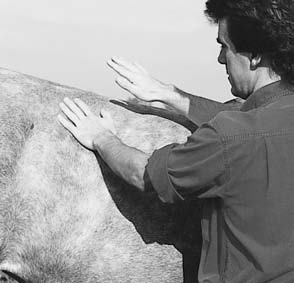Equine Massage: A Practical Guide (17 page)
Read Equine Massage: A Practical Guide Online
Authors: Jean-Pierre Hourdebaigt

3.25 Friction Movement
(A) thumb friction
(B) finger friction
(C) hand friction
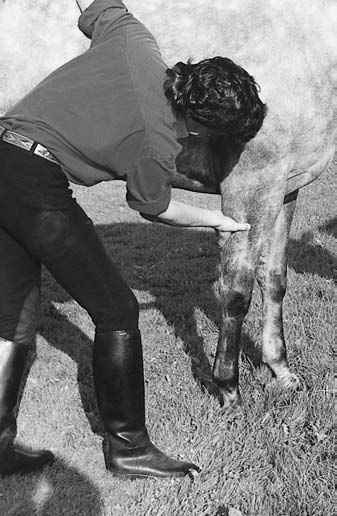
76
Equine Massage
Do not use friction on one specific area for too long; 2 to 3
minutes maximum is enough if no inflammation is present. It is better to reduce scar formation over the course of several massages than to take the risk of worsening the area and creating more inflammation. It is very important to intersperse your work with copious effleurage drainage every 20 or 30 seconds, and some wringing to keep the tissues warm.
When working a patch of scar tissue, start from the periphery and work toward the center of the scar with moderate pressure (8
to 12 pounds) to loosen the fibers. Drain thoroughly with effleurages.Then use friction across the whole fibrous patch, going sideways or up and down (depending on the nature of the scar formation) in a circular fashion, using a much heavier pressure (15
to 25 pounds). Assess the feedback signs of the horse. Remember to drain generously with effleurages every 20 or 30 seconds.
As you use friction to relieve new adhesions or to break down old fibrous masses, it is good to ice before and after treatment.This will ensure the numbing of the nerve endings and will minimize discomfort. Simply apply a cold pack or use the ice massage technique described in chapter 4.
3.26 Thumb Friction Movement
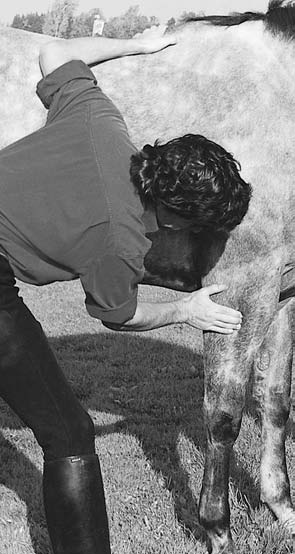
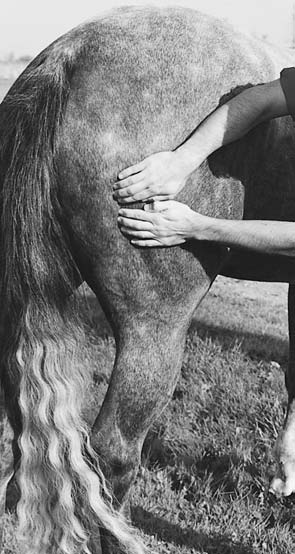
Principles and Concepts of Massage
77
3.27 Finger Friction Movement
3.28 Hand Friction Movement
Nerve Manipulation
Nerve manipulation consists of stroking, pressure, friction, and stretching. Owing to the nature of the nerve tissues and their function, be very gentle and careful in your work.
All these movements are mostly concerned with nerve maintenance and therapy. All are mechanically stimulating to the nerves except for the nerve stroking manipulation, which is a pure nervous reflex movement.
Your initial contact over the course of the nerve should be very light; use almost no pressure until you feel that the horse has accepted your work. Remember that an irritated or damaged nerve is extremely sensitive. Then you can progressively adapt your pressure. Even during the course of the treatment, however, too heavy a pressure or movements that are performed too quickly can trigger a very abrupt, almost panicky reaction from the animal. Be mindful of this. Here, these massage moves are presented in the order that they should be used to treat a nerve condition such as
neuralgia
, which is the aching of a nerve after a strain.
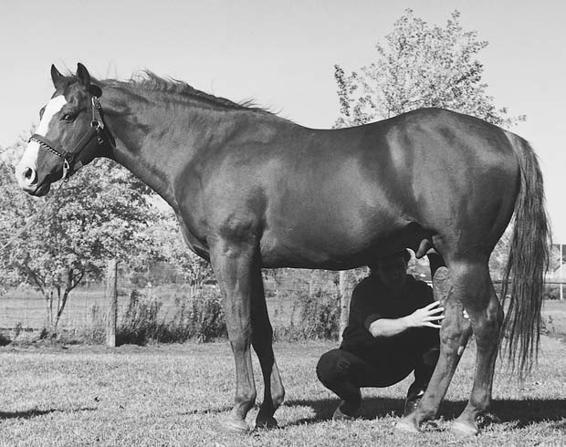
78
Equine Massage
Nerve Stroking
Employed along the course of a nerve, nerve stroking uses the same stroking massage move presented earlier; it will relax and give a grounding feeling to the animal. Again, no pressure is used beyond the weight of the fingertips over the skin. Because it would be irritating to the nerve, do not apply nerve stroking too long.
Since this is the first movement you will use in this treatment, be extremely cautious during the initial contact. Depending on the degree of inflammation and pain, the horse could be very jumpy.
You might consider cooling down the area before treating it.
Apply a cold cloth or hose it down. Do not apply ice directly over the course of the nerve. This would be very irritating, especially over the areas where the skin is very thin and the nerve is right underneath (the inside of the legs, for example). At the end of a nerve treatment, you can apply nerve stroking as a finishing touch to soothe and relax.
Nerve Pressure
Nerve pressure consists of small pressure points applied along the course of the nerve to restore feeling along the horse’s limbs.This renewed awareness will promote new nerve growth.
3.29 Nerve Stroking Movement
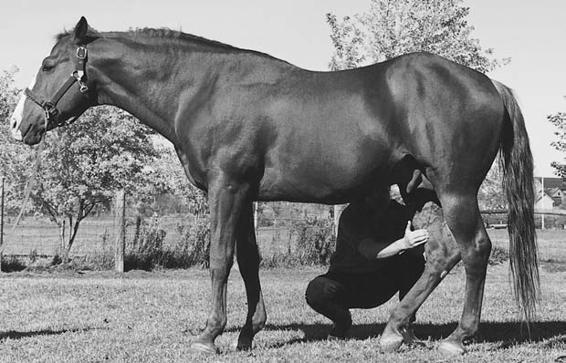
Principles and Concepts of Massage
79
3.30 Nerve Pressure Point Movement
Always use a light pressure, starting at 1 pound and progressively increasing to 2 or 3 pounds maximum. If the nerve course shows some inflammation, it would be beneficial to cool the area first (see cold hydrotherapy application, chapter 4). Use only very light pressure points afterwards (1 to 2 pounds), progressively increasing as the structure improves. Again, be very gentle and aware of the progress of your treatment. And be alert when using this massage move because the horse might abruptly move his leg in response to the pressure.
Nerve Friction
To perform nerve friction, use the friction massage move described earlier. Apply it along the course of a nerve to stimulate regeneration and new growth. Only apply nerve friction once the area is well warmed up through your massage treatment so your horse is well aware of your working that area.
When a nerve has been elongated (overstretched during a bad fall, for example), apply a light friction along the whole course of the nerve. This will strongly promote the regeneration of the nerve tissues. Do not proceed if the nerve shows strong signs of inflammation. Wait for the inflammation to go down. Use cold hydrotherapy, gentle stretching, and rest.
When a nerve has been totally severed (as with a bad cut, for example), you only need to work the few inches above the section that was injured.This action will strongly promote new nerve growth. Below the trauma, the distal section that was cut off will degenerate. It cannot be saved.
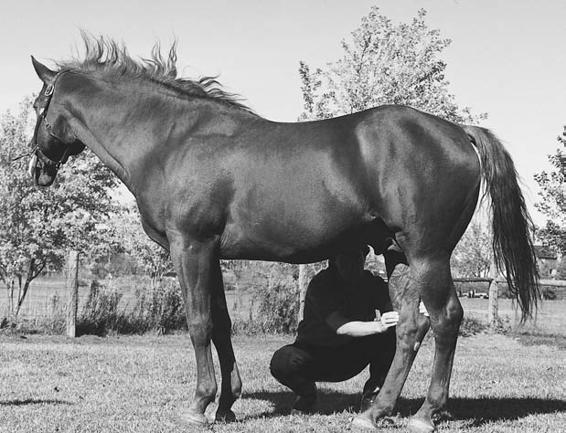
80
Equine Massage
3.31 Nerve Friction Movement
When using nerve friction, always be very gentle at the start, applying only 1 or 2 pounds of pressure. This move can be quite painful at times and your animal might react strongly. Apply cold hydrotherapy before and after treatment to numb the area. (For more information on Hydrotherapy, see chapter 4.) When dealing with a serious nerve problem (trauma, cut), consult your veterinarian before applying this move.
Use this massage therapy only in the chronic stage (past 72
hours) of an injury. Do not apply if the nerve is inflamed (symptoms of heat, extreme sensitivity).
Nerve Stretching
Nerve stretching is basically a regular stretch of the limb that will affect the course of the injured nerve (see chapter 8).This stretch is done much more cautiously than others, starting with a very small stretch and progressively getting deeper over the course of several sessions.
Remember that nerves—especially injured nerves—ache easily.
Never use the nerve stretch during the acute stage (first 24 hours) of an injury; stretching should only be used in the chronic stage (past 72 hours) of recovery. (For more information on injury recovery stages, see chapter 4.) If the nerve is inflamed, use cold applications to reduce the inflammation.

